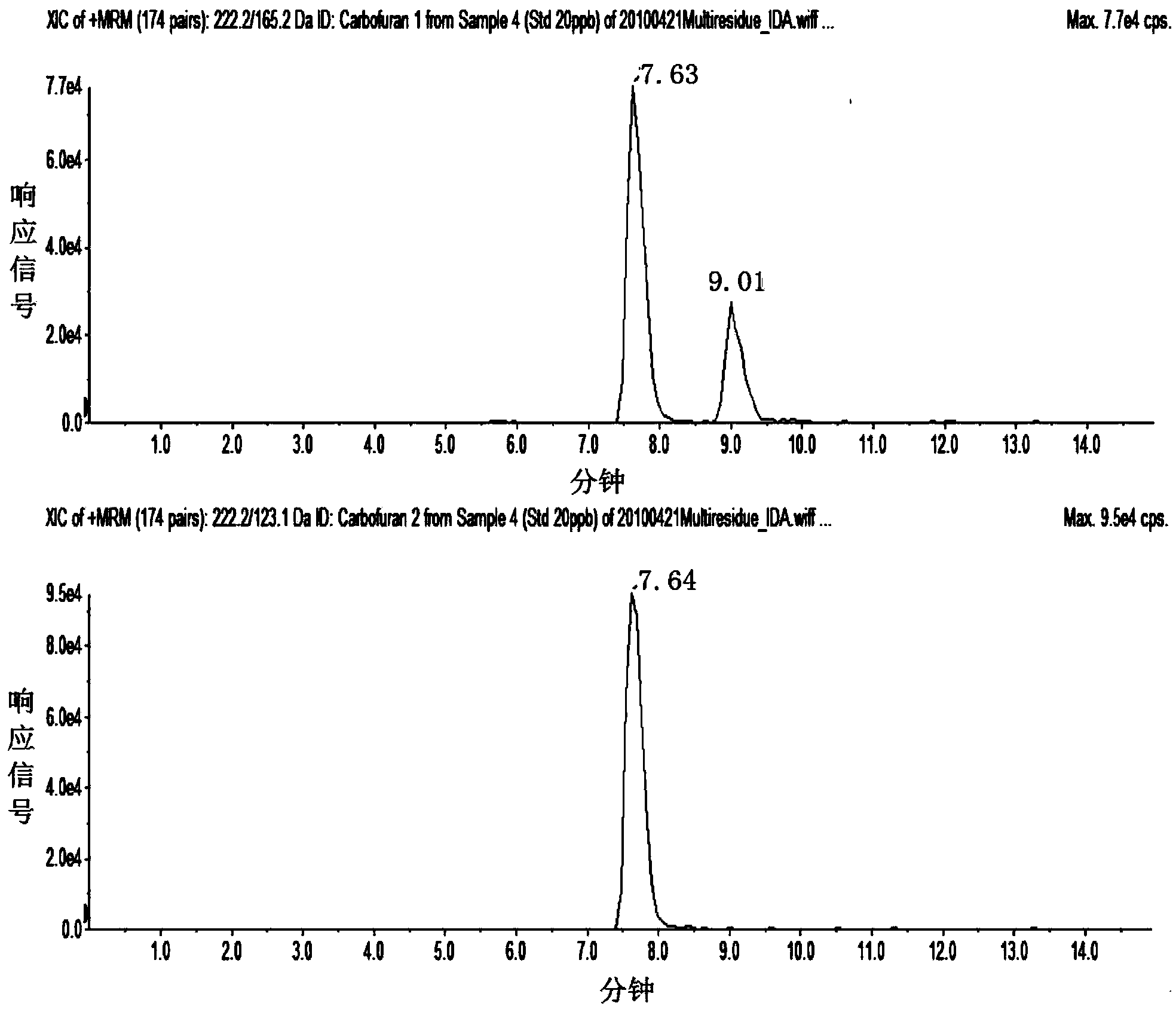Method for determination of pesticide residues in vegetable oils
A technology for pesticide residues and vegetable oils, applied in the field of determination of pesticide residues in vegetable oils, can solve the problems of high detection limit, poor sensitivity, and powerlessness of qualitative identification
- Summary
- Abstract
- Description
- Claims
- Application Information
AI Technical Summary
Problems solved by technology
Method used
Image
Examples
Embodiment 1
[0052] Embodiment 1: Optimization of chromatographic conditions
[0053] The properties of the 104 target compounds to be detected are quite different, and the choice of the mobile phase system plays an important role in the separation effect. In this example, in acetonitrile-water, methanol-water, methanol-ammonium acetate solution, ammonium acetate methanol solution - Select the best mobile phase system among the four solutions of ammonium acetate aqueous solution.
[0054]The column conditions are as follows:
[0055] Restek C18 chromatographic column (3μm, 2.1×100mm, Restek, USA);
[0056] Column temperature: 35°C;
[0057] Balance time: 5min;
[0058] Injection volume: 10μL;
[0059] Flow rate: 0.5mL / min;
[0060] Mobile phase: use the mobile phase composed of solution A and solution B for gradient elution, elution conditions: 0-8min, B from 20.0%-90.0%; 8-12min, B from 90.0%-100.0%; 12-14.8min , B maintained at 100.0%; 14.8-14.9min, B from 100.0%-20.0%; 15.0min sto...
Embodiment 2
[0072] Embodiment 2: Optimization of extraction reagents in mass spectrometry conditions
[0073] In this example, the APCI source and the ESI (+) ion source were selected. The experiment found that the noise baseline of the APCI source is low, but the response value of the target is also low, and the response under the ESI (+) condition is better, which meets the sensitivity requirement. Using a peristaltic pump to continuously inject at a flow rate of 10 μL / min, respectively inject 0.5 mg / L pesticide standard solutions into the ESI ion source, perform primary mass spectrometry analysis (Q1 scan) in positive ion detection mode, and obtain quasi-molecular ion peaks [ M+H]+, optimized declustering voltage. Perform secondary mass spectrometry analysis (product ion scanning) on quasi-molecular ion peaks to obtain full spectrum information of secondary mass spectrometry fragments, optimize collision energy, and establish a standard substance EPI spectral library at the same time...
Embodiment 3
[0086] Example 3: Optimization of Freezing Time in Mass Spectrometry Conditions
[0087] After optimizing the extraction steps, although most of the oil remained in the residue, a small part still entered the acetonitrile layer. In order to further purify, freezing was used to remove the oil. In the optimization of freezing time, 0h, 0.5h, 1.0h, 2.0h, 4.0h and 6.0h were selected as the optimization time selection scheme. Put the acetonitrile extraction layers obtained by different extraction methods into the -18°C refrigerator to freeze at the same time, take out 2mL of the extracts at intervals, dry them and weigh them, and use the subtraction method to draw the freezing effect curve, see image 3 . image 3 It is a freezing time optimization diagram, wherein, A, B, C, D, E, and F respectively represent the six extraction schemes of A-F in Example 2.
[0088] from image 3 It can be clearly seen that with the extension of freezing time, the oil content in the extract drops...
PUM
| Property | Measurement | Unit |
|---|---|---|
| Particle size | aaaaa | aaaaa |
Abstract
Description
Claims
Application Information
 Login to View More
Login to View More - R&D
- Intellectual Property
- Life Sciences
- Materials
- Tech Scout
- Unparalleled Data Quality
- Higher Quality Content
- 60% Fewer Hallucinations
Browse by: Latest US Patents, China's latest patents, Technical Efficacy Thesaurus, Application Domain, Technology Topic, Popular Technical Reports.
© 2025 PatSnap. All rights reserved.Legal|Privacy policy|Modern Slavery Act Transparency Statement|Sitemap|About US| Contact US: help@patsnap.com



